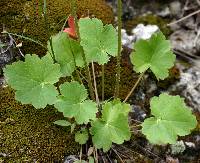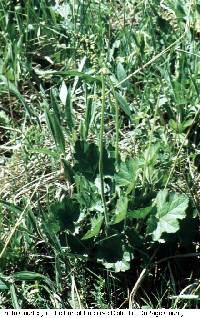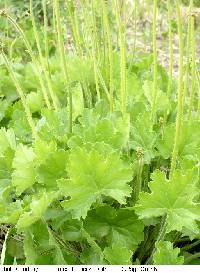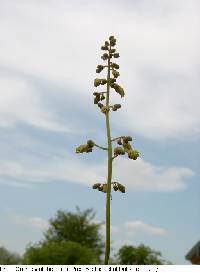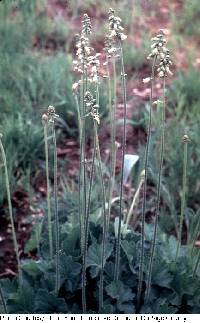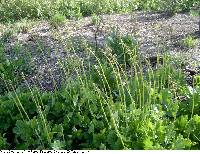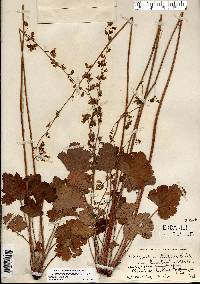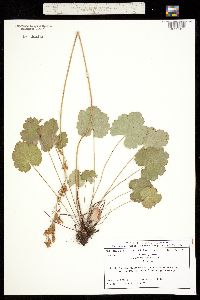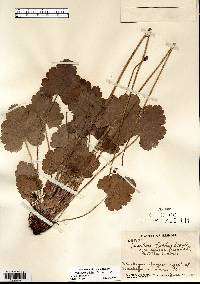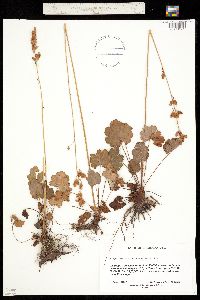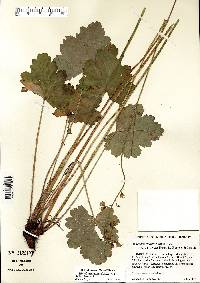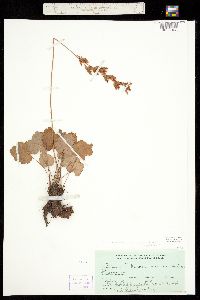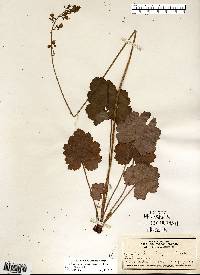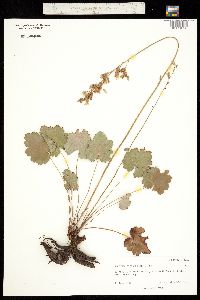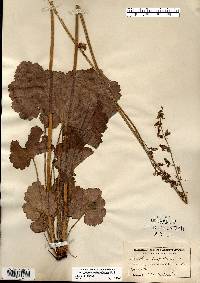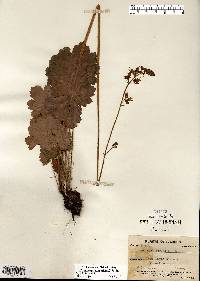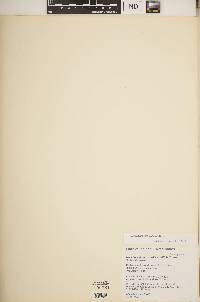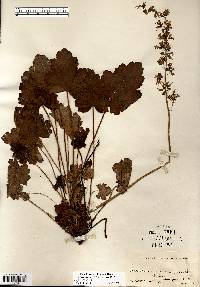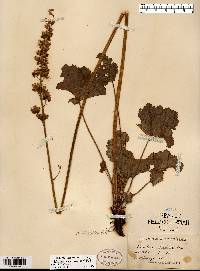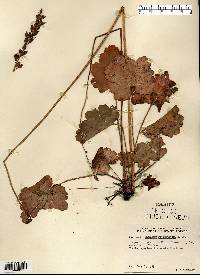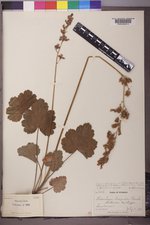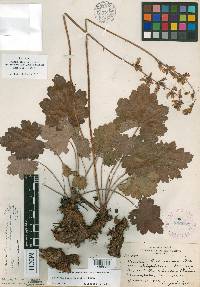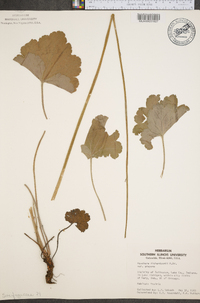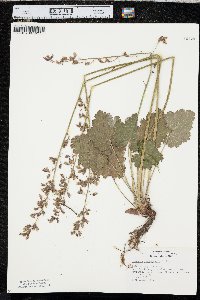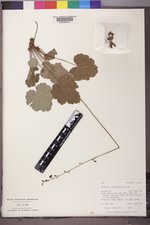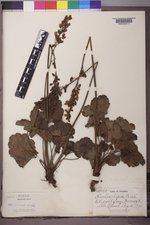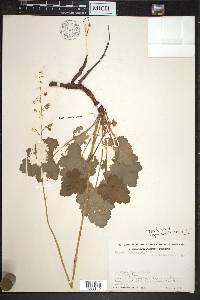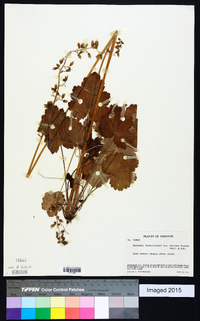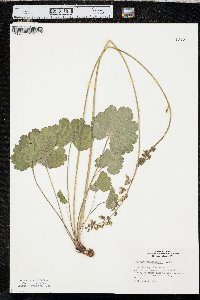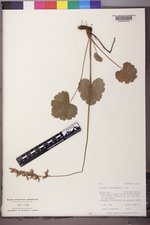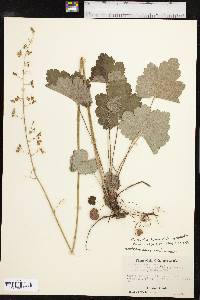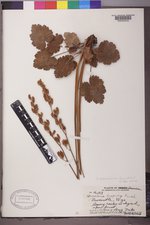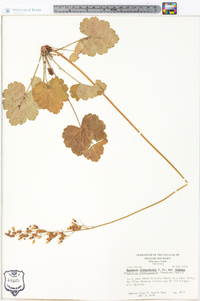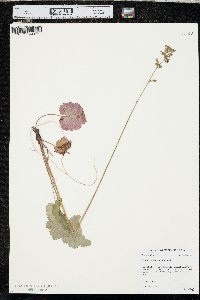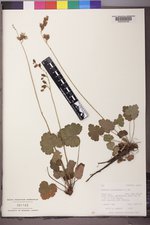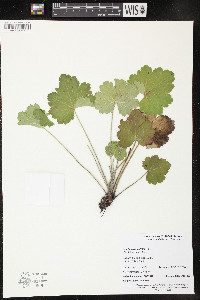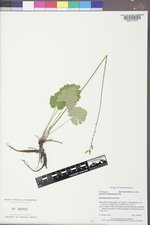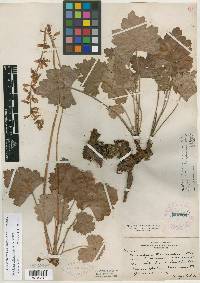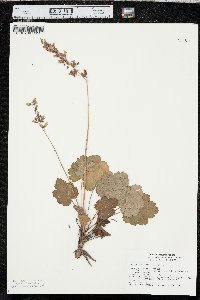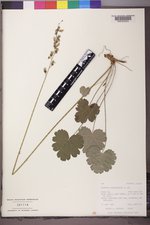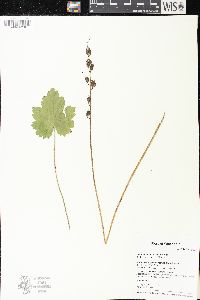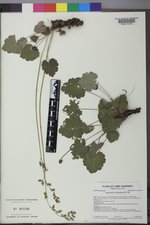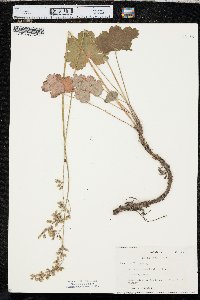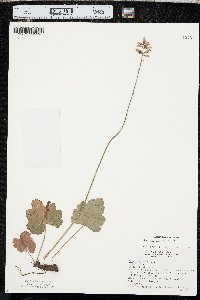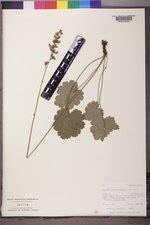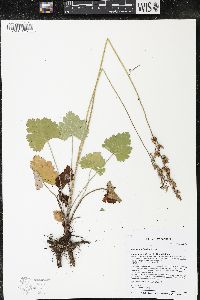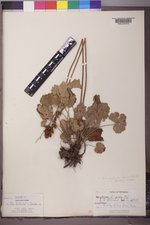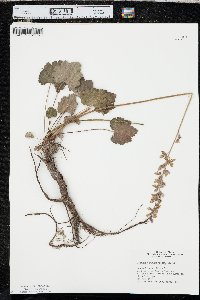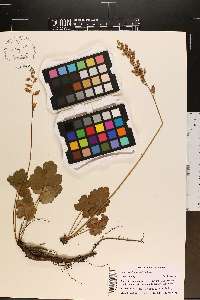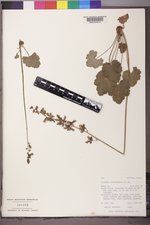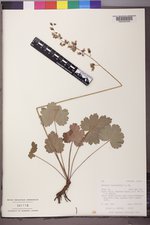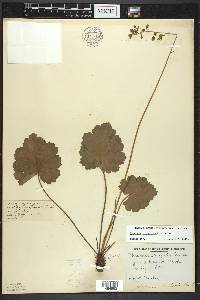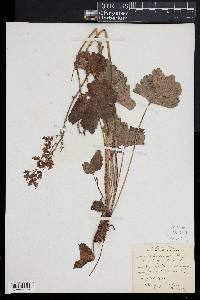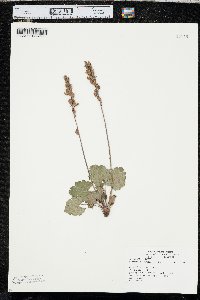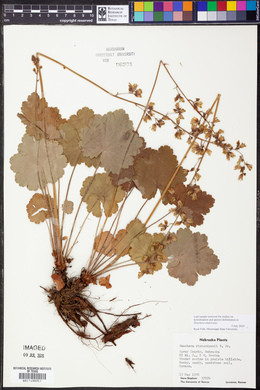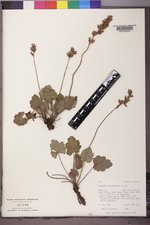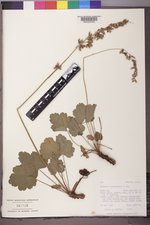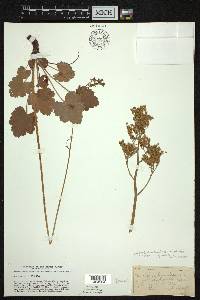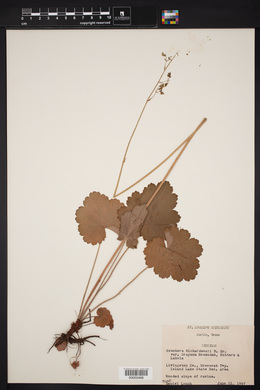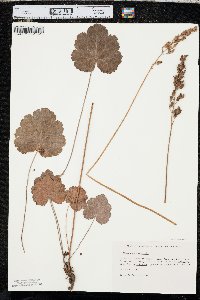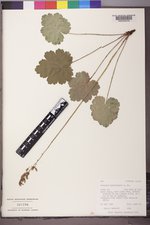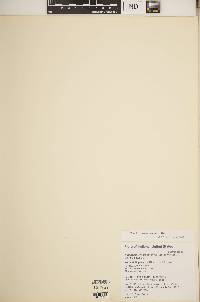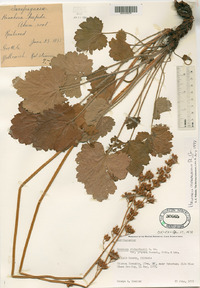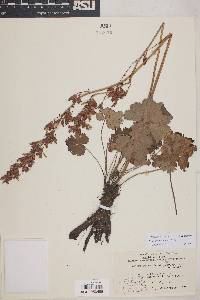Heuchera richardsonii
|
|
|
|
Family: Saxifragaceae
Richardson's Alumroot, more...Richardson’s alum-root
[Heuchera richardsonii var. affinis Rosend., Butters & Lakela, moreHeuchera richardsonii var. grayana Rosend., Butters & Lakela, Heuchera richardsonii var. hispidior Rosend., Butters & Lakela] |
Herbs acaulescent; caudex branched. Flowering stems (7-)20-95 cm, densely long stipitate-glandular. Leaves: petiole densely or sparsely long or short stipitate-glandular; blade broadly ovate or cordate, deeply 5-7-lobed, 2.5-10 cm, base cordate or nearly truncate, lobes rounded, margins dentate, apex acute, surfaces long stipitate-glandular abaxially, glabrous or long stipitate-glandular adaxially. Inflorescences dense to diffuse. Flowers: hypanthium strongly bilaterally symmetric, free 2-7 mm, green, campanulate, abruptly inflated distal to adnation to ovary, 5-14 mm, short stipitate-glandular; sepals erect, green-tipped, equal, 1.3-4.2 mm, apex rounded (sinuses wider than petals); petals erect, green or greenish white, rarely pink, narrowly spatulate, unlobed, 1.3-4 mm, margins finely dentate or coarsely fimbriate; stamens 1.5 mm included to 4 mm exserted; styles from 0.6 mm included to 0.3 mm exserted, 4-6 mm, to 0.1 mm diam. Capsules ovoid, 7-14.5 mm, beaks divergent, not papillose. Seeds dark or very dark brown, ellipsoid, 0.6-0.9 mm. 2n = 14, 28. Flowering May-Jun. Moist or dry, low or upland prairies, basic rock outcroppings and bluffs, sandy, dry woods; 200-800 m; Alta., B.C., Man., N.W.T., Ont., Sask.; Colo., Ill., Ind., Iowa, Kans., Mich., Minn., Mo., Mont., Nebr., N.Dak., Okla., S.Dak., Wis., Wyo. Heuchera richardsonii intergrades with H. americana where their ranges overlap in Arkansas, Illinois, Indiana, Michigan, Missouri, and Oklahoma; the intergrading form is recognized here as H. americana var. hirsuticaulis. Heuchera hispida (H. americana var. hispida here; see thereunder) was confused with H. richardsonii for almost a hundred years, until C. O. Rosendahl et al. (1933) pointed out that the plants from the Midwest then passing as H. hispida Pursh were distinct from Pursh´s species and were H. richardsonii.
Perennial herb 20 cm - 0.9 m tall Leaves: basal, with a long and stiff-haired stalk. The blade reaches 1.3 cm long, is broadly heart-shaped to egg-shaped with seven to nine shallow lobes, each lobe having three to five tiny rounded lobes, and is hairless or nearly so above and hairy (especially on veins) beneath. Flowers: borne on a branched narrow inflorescence (panicle), green to greenish white, with five stamens and a single-chambered ovary. The sepals are fused into a very unequal-sided tube measuring 7 - 10 mm on the upper side and half as long on the lower side, and the five 2 - 4 mm long petals are narrow spoon-shaped and finely toothed. Fruit: a two-beaked elliptic capsule containing egg-shaped seeds with one or two flattened faces. Flowering stem: leafless but with a few small scale-like bracts, stiffly hairy with hairs becoming glandular near tip. Similar species: The flowers of Heuchera americana are shorter than 5.5 mm and the sepal tube is equal-sided to slightly unequal-sided. Sullivantia sullivantii has up to two leaves on the flowering stem, petals that wither but persist, a two-chambered ovary, and winged seeds. Tiarella cordifolia has an unbranched inflorescence (raceme) with each flower having petals and stamens (ten) that are more conspicuous than the sepals. Each species of Mitella has an unbranched inflorescence (raceme), with each flower having ten stamens, pinnately fringed petals, and an ovary that is somewhat flattened at the top. In addition, Mitella diphylla has two opposite leaves on the flowering stem, while Mitella nuda may have one. Flowering: mid May to July Habitat and ecology: Occasional in prairies and open woods, sometimes surviving in degraded prairies. Occurence in the Chicago region: native Etymology: Heuchera is named after German botanist Johann Heinrich von Heucher (1677 - 1747). Richardsonii is named after Sir John Richardson (1787 - 1865), the discoverer of the species. Author: The Morton Arboretum Plants 2-9 dm; scape with a few small, scale-like bracts; petioles strongly spreading-hirsute; lvs broadly cordate-ovate, glabrous or nearly so above, hairy at least on the veins beneath, shallowly 7-9-lobed, each lobe with 3-5 rounded to acute, mucronate lobules; stems ±hirsute, becoming glandular above; infl relatively narrow and congested; fls very oblique, 7-10 mm on the upper side, half as long below, with wide sinuses between the sep; free part of the hypanthium 2-6 mm; pet mostly green or greenish-white (pink), 2-4 mm, narrowly spatulate, finely toothed; stamens shortly included to long-exserted; style shortly included to shortly exserted; 2n=14, 28. Prairies and dry woods; s.c. Mich. and nw. Ind. to nw. Ark. and ne. Okla., w. and n. to Colo. and Alta. May-July. Gleason, Henry A. & Cronquist, Arthur J. 1991. Manual of vascular plants of northeastern United States and adjacent Canada. lxxv + 910 pp. ©The New York Botanical Garden. All rights reserved. Used by permission. From Flora of Indiana (1940) by Charles C. Deam [Deam recognizes two varieties of H. richardsonii that differ in flower size: mostly 5-7 mm in var. affinis and mostly 6-10 mm in var. grayana.] The small flowered variety] prefers sandy soil and grows mostly on the slopes and banks of streams and lakes. Our specimens are all from the lake area except the Vigo County specimen which was found in the Heckland Prairie. [The large flwoered] variety prefers a very sandy soil and is found both in moist and dry situations in the open or in woodland bordering streams and lakes. ...... Indiana Coefficient of Conservatism: C = 8 Wetland Indicator Status: FACU |
|
|
|


